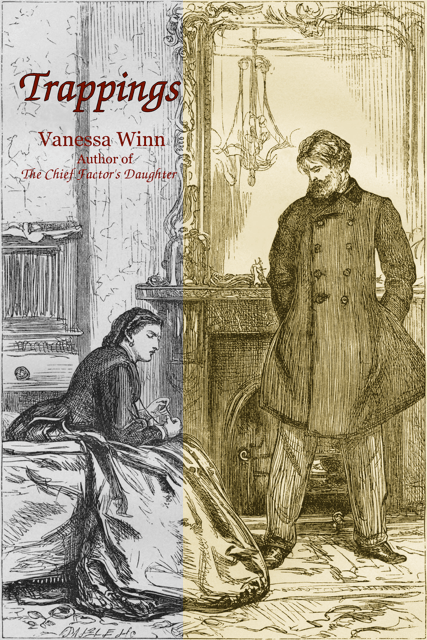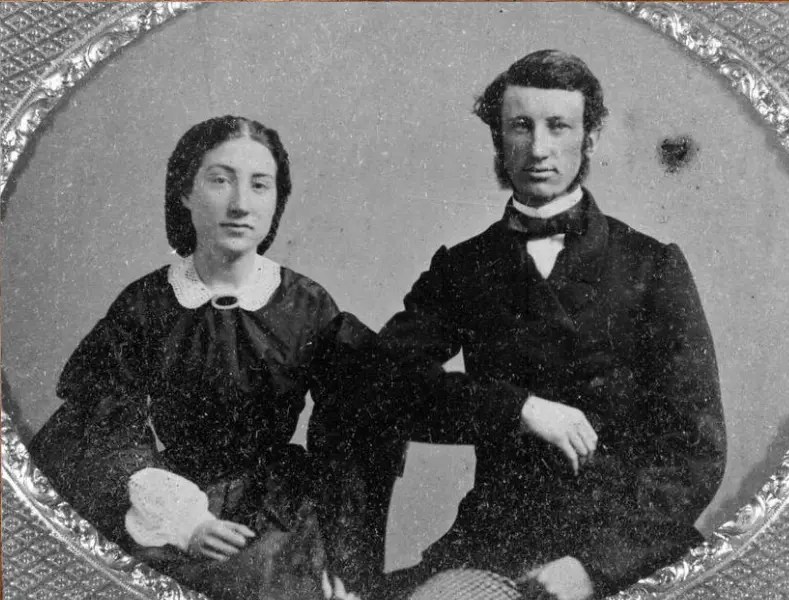For fans of historical fiction and/or Canadian history, Trappings is a book based on real people and events in mid-nineteenth century British Columbia. What’s more, it offers a woman’s view of politics and life during this time.
Winn’s passion for her subject shows in the historical details. Trappings tells a personal story of a woman and her family against the laws, customs, and events of the time; the small pox epidemic of 1862, the gold rush of 1858, the San Francisco earthquake of 1868, Queen Victoria’s birthday celebrations (including a blindfolded wheelbarrow race and a greased-pole event), the birth of the Dominion of Canada, and the recent history of several First Nations communities (from which Kate’s own family was partly descended). You will also learn interesting tidbits about Point Ellice House, the Hudson’s Bay Company, the Vancouver Coal Mining Company, Emily Carr, and Sir Joseph Bazalgette – creator of London’s sewer system in the time of the “the Great Stink” and the cousin of Captain George Bazalgette who was a good friend of Kate (Work) Wallace and Charles Wallace. Some people really got around back then. You might be surprised by the connections you discover.
Amid the recovery from recession, an underlying note of alarm sounded through the murky city in late September. Another wave of disease was suddenly carrying off the Indians. Mr. Sebright Green was calling for their protection, and Kate appreciated him a little more. The general dread of small pox was countered by the opinions of some medical gentlemen that it was a different malady altogether. Regardless, the physicians in town were kept busy vaccinating the citizens.
You don’t have to be a history buff to enjoy this book – not if you enjoy stories about women; women helping other women, women helping themselves in a world full of men’s laws.
Kate Work is one of the daughters of John Work, Chief Factor of the Hudson’s Bay Fur Trading Company. “A fur trader might provide his daughter with the trappings of success, but even a Chief Factor could not free her from wedlock, once caught in the matrimonial snare.” Although several of Kate’s sisters, ahead of her, had secured successful (and even happy) marriages, Kate herself hadn’t been so fortunate. She was happy at first, but it wasn’t long before she began to doubt her husband’s devotion, as well as his business savvy and ability to take care of Kate’s inheritance from her father; something that meant a great deal to her: “She shook her head in small, jerky movements, with the awful realization that, indeed, the house was never really hers...” In addition, Kate and Charles had lost three of their four children.
Kate’s husband, Charles Wentworth Wallace, was born into a prominent family from Halifax, Nova Scotia. They moved West after a scandal involving his father, in the hopes of starting over; Kate only just learned about this during the public debacle of their own financial troubles.
Having believed Confederation might strengthen Charles’ ties to Nova Scotia, she was puzzled by his position against it. He was churlish in his response to her careful questions. If he regretted his inability to run himself, he did not admit it to her. Politics were simply not the dominion of a lady.
“You had better keep your attention, Kate, where it is needed, to your family here. There is plenty to attend to under your own roof.”
She bit her tongue, as to the roof, which was decidedly not her own. Nor his, she might have added.
Kate was trapped. With her failing health, she had to think of her remaining daughter, Eliza, who legally belonged to Charles. How to ensure a future for Eliza that included all the love and warmth Kate experienced as a child?
Trappings is the kind of book that pulls you in slowly but surely. If the historical customs and events don’t suck you in, the warmth of Kate’s large family is sure to. And if you’re like me, you’ll be googling them all to find out what became of their descendants. We need more stories like this; ones that give life to little-known, over-looked women of the past.
Have you read any historical novels based on real women lately? Any to recommend?




Interesting, Naomi. All your reviews are!! And doesn’t the body language in the photo tell a story!
Thanks for reading, Donna, as always! 🙂
Couldn’t agree more with that final sentence!
Little did they know that someday people like us would be fascinated by their lives!
This sounds so interesting. I’ve read countless books like this set in Britain (and a few set in the US) so it would be refreshing to try one set in Canada!
It’s my favourite way to learn some history! 🙂
I love domestic history, and certainly don’t know enough about Canadian history, this would seem the perfect way to learn!
Domestic history is the perfect term for it – thanks, Jane!
This sounds so good Naomi and I totally agree, we need more light shone on women like this.
If they had any idea we would read about them some day, I wonder what their biggest message to us would be?
This sounds really interesting! There is so much of BC history I still don’t know!
I was thinking of you while reading this – wondering if you already knew all this stuff! 🙂
I don’t! Any Canadian history I learned at school was really focused on Ontario/Quebec. When I lived in Victoria I learned more about the local history there but the rest of BC is still kind of a mystery to me!
This reminds me of the book Almost Famous Women by Megan Mayhew Bergman. It sent me scrambling for Google after every story!
I would love to read that book!
Wow this sounds like a really informative and unique novel-truly a piece of Canlit! And once again, historical fiction makes me so relieved to be alive today, and not back then-gosh, the things people, especially women had to endure is just unbelievable.
I feel like it’s unfair that they had to live then and we get to live now. There must have been Some perks… but I really can’t think of any right now.
I know what you mean, I just feel incredibly lucky to only know what it’s like to live right now, as opposed to back then. Ugh!
The Australian woman writer of the same period is Catherine Helen Spence, though she had the good sense to stay unmarried, not that she had an inheritance a husband might want to get his hands on (unlike, say, George Sand). Australian women authors were generally quite reluctant to commit their heroines to marriage, though Spence’s Clara Morrison succumbs eventually.
One question, Who’s the illustrator for the cover? It looks a little like George du Maurier who wrote and illustrated Trilby.
Good question, Bill! I asked Vanessa and here’s what she said: “The cover image is an illustration by John Everett Millais, for one of Anthony Trollope’s novels, The Small House at Allington. It was published in the 1860s — as you know, the era of Trappings. Many novels in the 19th century were illustrated, and I wanted something that reflected the period. The themes of this Trollope novel also suited Trappings. My designer added the sepia / black & white contrast to accentuate the rift between the couple.”
You’ve done a great job describing this book so we can tell if it’s a great reading match for us! (I’m not sure it’s a match for me, but I still enjoyed reading your thoughts on it.) Another I’ve read recently which would fit with historical fiction somewhat, is Lauren Groff’s Matrix, based on a 12thC poet, born in France and living in England. BUT that’s basically all anyone knows about her for sure, the rest is conjecture, so Groff was free to do a fair bit of imagining. (I think you’d love it if only because there’s a pet theme of yours in it, but I won’t say what to avoid spoilers.)
Okay, well now I have no choice but to check that one out! I’ve just added it to my “favourites” list! 🙂
Has it reached the stage of “not admitting its size” yet? 🙂
Haha! Almost! 😉
Is that Marie de France, author of the fables known as Ysopets? I might have to add Matrix to my own list.